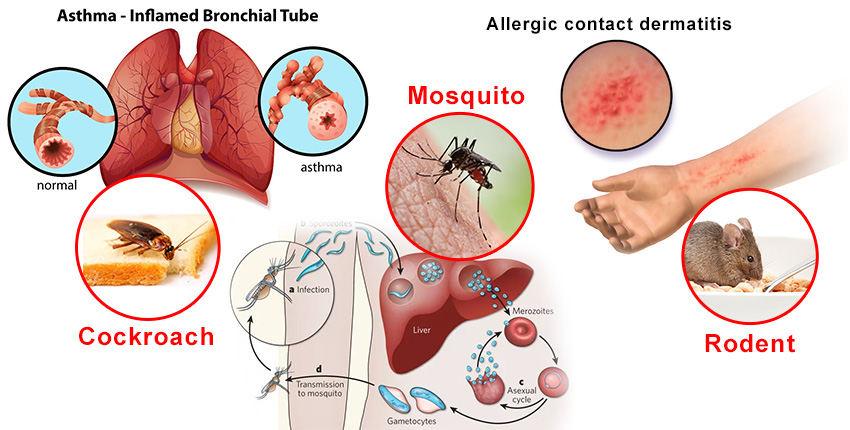The Basic Principles Of Eco Bed Bug Exterminators Dc
Table of ContentsRumored Buzz on Eco Bed Bug Exterminators DcThe Greatest Guide To Eco Bed Bug Exterminators DcSome Known Details About Eco Bed Bug Exterminators Dc Unknown Facts About Eco Bed Bug Exterminators DcSome Known Details About Eco Bed Bug Exterminators Dc
Due to the fact that pesticides are poisonous, they are likewise possibly hazardous to people, animals, other microorganisms, and the atmosphere. For that reason, individuals who use pesticides or consistently can be found in call with them have to recognize the family member toxicity, potential health results, and preventative actions to minimize exposure to the items they utilize. Hazard, or risk, of using pesticides is the possibility for injury, or the level of danger associated with making use of a chemical under a provided set of conditions.
Applicators can decrease or nearly eliminate exposure-- and hence lower danger-- by following the label instructions, utilizing personal protective garments and devices (PPE), and dealing with the chemical appropriately. For instance, more than 95 percent of all chemical direct exposures come from facial exposure, primarily to the hands and forearms. By wearing a set of unlined, chemical-resistant handwear covers, this kind of exposure can be nearly gotten rid of.
The unsafe impacts that occur from a solitary exposure by any kind of path of entry are termed "intense impacts." The four paths of direct exposure are facial (skin), inhalation (lungs), oral (mouth), and the eyes. Severe toxicity is figured out by checking out the dermal toxicity, breathing toxicity, and dental poisoning of test pets.
Eco Bed Bug Exterminators Dc Fundamentals Explained
Intense poisoning is determined as the quantity or focus of a toxicant-- the a.i.-- required to kill 50 percent of the pets in a test populace. This step is normally shared as the LD50 (deadly dosage 50) or the LC50 (dangerous focus 50). Additionally, the LD50 and LC50 values are based upon a single dosage and are videotaped in milligrams of chemical per kilo of body weight (mg/kg) of the guinea pig or partially per million (ppm).
The reduced the LD50 or LC50 value of a pesticide product, the better its poisoning to people and pets. Pesticides with a high LD50 are the least toxic to humans if used according to the directions on the item label. The chronic poisoning of a pesticide is figured out by subjecting guinea pig to lasting direct exposure to the energetic ingredient.
The chronic toxicity of a pesticide is extra hard than severe toxicity to figure out with research laboratory evaluation. Products are classified on the basis of their relative intense poisoning (their LD50 or LC50 values). Chemicals that are classified as very hazardous (Toxicity Category I) on the basis of either oral, dermal, or inhalation poisoning should have the signal words DANGER and poisonous substance printed in red with a skull and crossbones sign plainly showed on the front panel of the plan label.
The acute (solitary dosage) dental LD50 for chemical products in this team varies from a trace total up to 50 mg/kg. For example, direct exposure of a couple of declines of a product taken by mouth could be fatal to a 150-pound person. Some chemical products have simply the signal word risk, which informs you absolutely nothing about the severe toxicity, simply that the product can trigger severe eye damages or severe skin inflammation
The Ultimate Guide To Eco Bed Bug Exterminators Dc
In this classification, the intense oral LD50 arrays from 50 to 500 mg/kg. A teaspoon to an ounce of this material could be fatal to a 150-pound person (how to get rid of bed bugs). Pesticide products classified as either a little toxic or fairly nontoxic (Toxicity Groups III and IV) are needed to have the signal word CAUTION on the pesticide tag

The Best Strategy To Use For Eco Bed Bug Exterminators Dc
All pesticide toxicity chemicalPoisoning worths the LD50, can be found on the product's Item Safety Data Sheet (MSDS). Chemical labels and MSDS can be acquired from stores or makes. Furthermore, most products additionally know that can be located on the web. The symptoms of chemical poisoning can vary from a mild skin irritation to coma and even fatality.
People also vary in their sensitivity to different degrees of these chemicals. Some individuals may show no response to an exposure that might create severe disease in others (bed bug treatment). Due to the fact that of possible health and wellness problems, pesticide individuals and trainers should acknowledge the typical symptoms and signs of pesticide poisoning. The results, or signs and symptoms, of pesticide poisoning can be generally defined as either topical or systemic.
The Greatest Guide To Eco Bed Bug Exterminators Dc
Dermatitis, or inflammation of the skin, is approved as the most typically reported topical result linked with chemical direct exposure. Some people tend to cough, hiss, or sneeze when exposed to chemical sprays.
This symptom generally subsides within a couple of mins after an individual is gotten rid of from the direct exposure to the irritant. A reaction to a chemical item that a fantastic read creates somebody not just to sneeze and cough but likewise to develop extreme acute respiratory system symptoms is extra likely to be a real hypersensitivity or allergic reaction.
Systemic results are quite different from topical results. They commonly happen far from the initial point of call as a result of the pesticide being absorbed right into and distributed throughout the body. Systemic effects usually include queasiness, vomiting, fatigue, migraine, and digestive conditions. In sophisticated poisoning cases, the person may experience adjustments in heart rate, difficulty breathing, convulsions, and coma, which can lead to death.